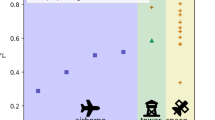Abstract
Net ecosystem production (NEP), defined as the difference between gross primary production and total ecosystem respiration, represents the total amount of organic carbon in an ecosystem available for storage, export as organic carbon, or nonbiological oxidation to carbon dioxide through fire or ultraviolet oxidation. In some of the recent literature, especially that on terrestrial ecosystems, NEP has been redefined as the rate of organic carbon accumulation in the system. Here we argue that retaining the original definition maintains the conceptual coherence between NEP and net primary production and that it is congruous with the widely accepted definitions of ecosystem autotrophy and heterotrophy. Careful evaluation of NEP highlights the various potential fates of nonrespired carbon in an ecosystem.

Similar content being viewed by others
References
Broecker WS, Takahashi T, Simpson HJ, Peng TH. 1979. Fate of fossil fuel carbon dioxide and the global carbon budget. Science 206:409–18
Caspersen JP, Pacala SW, Jenkins JC, Hurtt GC, Moorcroft PR, Birdsey RA. 2000. Contributions of land-use history to carbon accumulation in US forests. Science 290:1148–1151
Chapin FS. III, Matson PA, Mooney HA. 2002. Principles of terrestrial ecosystem ecology. New York: Springer
Cole JJ, Pace ML, Carpenter SR, Kitchell JF. 2000. Persistence of net heterotrophy in lakes during nutrient addition and food web manipulations. Limnol Oceangr 45(8):1718–30
Hamilton JG, DeLucia EH, George K, Naidu SL, Finzi AC, Schlesinger WH. 2002. Forest carbon balance under elevated CO2. Oecologia 131:250–60
Hanson PC, Bade DL, Carpenter SR, and Kratz TK. 2003. Lake metabolism: relationships with dissolved organic carbon and phosphorus. Limnol Oceanogr 48:1112–9
Lichter J. 1998. Primary succession and forest development on coastal Lake Michigan sand dunes. Ecol Monogr 68:487–510
Luz B, Barkan E, Bender ML, Thiemens MH, Boering KA. 1997. Triple-isotope composition of atmospheric oxygen as a tracer of biosphere productivity. Nature 400:547–50
Randerson JT, Chapin FS, Harden JW, Neff JC, Harmon ME. 2002. Net ecosystem production: a comprehensive measure of net carbon accumulation by ecosystems. Ecol Appl 12:937–47
Raymond PA, Cole JJ. 2003. Increase in the export of alkalinity form North America’s largest river. Science 302:88–91
Schlesinger WH. 1997. Biogeochemistry: An Analysis of Global Change. 2nd ed. Academic Press, San Diego, p. 159
Schulze ED, Wirth C, Heimann M. 2000. Managing forest after Kyoto. Science 289:2058–2059
Siegenthaler U, Sarmiento JL. 1993. Atmospheric carbon dioxide and the ocean. Nature 365 (9):119–25
Woodwell GM, Whittaker RH. 1968. Primary production in terrestrial ecosystems. Am Zoologist 8:19–30
Author information
Authors and Affiliations
Corresponding author
Rights and permissions
About this article
Cite this article
Lovett, G.M., Cole, J.J. & Pace, M.L. Is Net Ecosystem Production Equal to Ecosystem Carbon Accumulation?. Ecosystems 9, 152–155 (2006). https://doi.org/10.1007/s10021-005-0036-3
Received:
Accepted:
Published:
Issue Date:
DOI: https://doi.org/10.1007/s10021-005-0036-3




